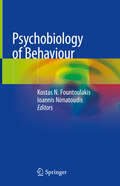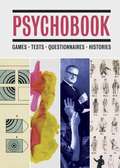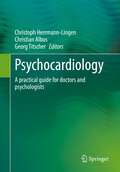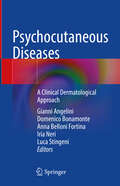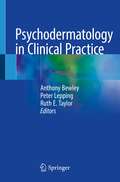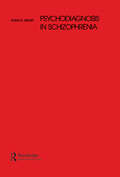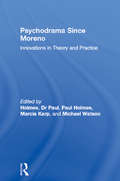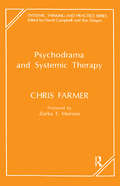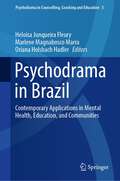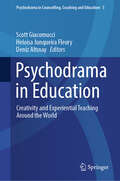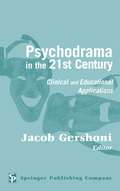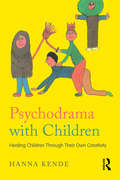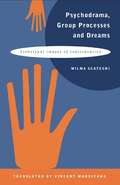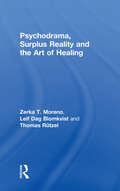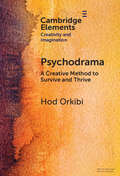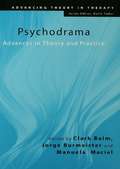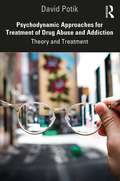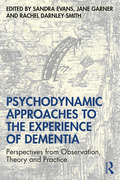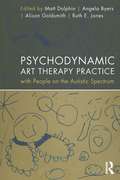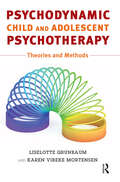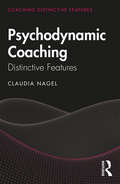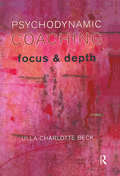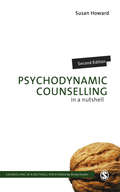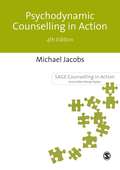- Table View
- List View
Psychobiology of Behaviour
by Kostas N. Fountoulakis Ioannis NimatoudisThe book provides a comprehensive reference on the neurobiological understanding of behaviour, how behaviour is regulated by the brain, and how such behaviours in turn influence the brain. The work offers an introduction to neural systems and genetics/epigenetics, followed by detailed study of a wide range of behaviours – temperament and personality, instincts and drives, memory and cognitive function, sex and sexual differentiation, ethology and evolutionary biology, aging, drug abuse and other problematic behaviors, psychophysiology and ultimately the links to biological psychiatry and psychopharmacology. Research findings on the neural basis of social behaviour are integrated across different levels of analysis, from molecular neurobiology and neural systems/behavioural neuroscience to fMRI imaging data on human social behaviour. The content covers research on both normal and abnormal behaviours, as well as developmental aspects. The target audience includes psychiatrists, neurologists, nurses, psychologists and all researchers and advanced students in behavioural, social and developmental neuroscience, as well as clinical neuroscientists.
Psychobook: Games, Tests, Questionnaires, Histories
by Lionel Shriver Wall Oison Mel Gooding Julian RothensteinWho knew a trip to the therapist could be so much fun, even aesthetically rewarding? Beyond sharing feelings or complaining about your mother, Psychobook reveals the rich history of psychological testing in a fascinating sideways look at classic testing methods, from word-association games to inkblots to personality tests.Psychobook includes never-before-seen content from long-hidden archives, as well as reimagined tests from contemporary artists and writers, to try out yourself, at home or at parties. A great ebook for the therapist in your life and the therapist in you, for anyone interested in the history of psychology and psychological paraphernalia, or for anyone who enjoys games and quizzes. Psychobook will brighten your day and outlook.
Psychocardiology: A practical guide for doctors and psychologists
by Christoph Herrmann-Lingen Christian Albus Georg TitscherPsychosomatic diagnostics and therapy are of increasing importance in the acute treatment, prevention and rehabilitation of cardiovascular diseases. The connection between heart disease and the psyche as well as the psychosocial concomitant symptoms is well documented. Basics of cardiology and psychosomatic medicine Doctor-patient relationship Ethical issues, gender effects, psychocardiology along the lifespan Psychosomatic problem areas and comorbidities Causes and consequences: Personality factors, risk behaviors, depression, anxiety disorders Specific diagnostics and treatment concepts - outpatient and inpatient Interdisciplinary cooperationAcute Cardiology, Heart Failure Units and Rehabilitation In accordance with German and European recommendations and guidelines, among others Position Paper on the Importance of Psychosocial Factors in Cardiology from the DGK (German Society of Cardiology) National Health Care Guideline Chronic CHD ESC Guidelines on CVD Prevention in Clinical Practice Suitable for the courses according to the curricula "Basic Psychocardiological Care" (D) and "Cardiological Psychosomatics" (A). For deepening the corresponding contents of the courses "Basic Psychosomatic Care". The book offers cardiologists, internists, general practitioners, psychotherapists and psychologists all practice-relevant basics to be able to treat their patients in the best possible way.
Psychocutaneous Diseases: A Clinical Dermatological Approach
by Domenico Bonamonte Gianni Angelini Iria Neri Anna Belloni Fortina Luca StingeniThe terminology, classification, diagnosis and treatment of dermatological factitious disorders, falling within the broad scope of self-induced dermatological diseases, are the subject of open debate. The complexity of the topic is also linked to the involvement of different health professions who often refer to different classifications, whereas patients with these conditions need a consistent multidisciplinary approach. The purpose of this work, resulting in decades of field experience and of the joint efforts of both dermatologists and psychiatrists, is to clarify the terminology of these disorders and, above all, to analyze their clinical characteristics in detail, the first and pivotal sign of suspicion and diagnosis. Artificial dermatitis are self-induced diseases caused by various means and for diverse purposes. Illness can be mimicked with unlawful purposes, or to take advantage of professional situations (obtaining extension of illness, recognition of the condition as an occupational disease, reaching a higher class of invalidity). In these cases, the simulators are aware of their own action and its purposes. Conversely, there are cases of self-induced dermatitis dictated by psychiatric problems, such as psychosis, intellectual disability and personality disorders. Intrinsic motivation of such lesions is different: patient intends to draw attention, reacts to difficult environmental situations by involuntary somatization of the skin. Skin artifacts of illicit intent are true "simulations", while the lesions caused unconsciously by subjects with psychological disorders are "pathomimies". In addition to the groups of true simulation and “pathomimia”, another group of self-provoked dermatoses is due to coercive habits (excoriations, tics) in conscious subjects who recognize the urgency of a self-harming action. Psychocutaneous Diseases leaves room to the clinic features and motivations of artifacts, both perpetuated on oneself and on other people ("by proxy" factitious disorders). The topic is completed by the addition of chapters by psychiatric specialists, in order to address pathogenetic problems and therapeutic guidelines, as well as contributions that integrate the approach with medico-legal expertise. This unique work will support diagnosis by dermatologists, but also psychiatrists, psychologists, internists, forensic doctors and general practitioners.
Psychodermatology in Clinical Practice
by Ruth E. Taylor Anthony Bewley Peter LeppingThis book represents a simple, practical resource for all healthcare professionals working with dermatological patients with psychological aspects to their disease. The emphasis is on effective guidance rather than exhaustive case reviews, providing readers with a manual on the appropriate way to approach management of the patient in each case. Comprehensive in coverage, but concise in its delivery of information, Psychodermatology in Clinical Practice presents an idealized approach to management of psychodermatology patients within a global perspective, and provides practical tools to aid assessment of patients and in the decision-making process. It is suitable for dermatologists, psychiatrists and psychologists, dermatology nursing staff, primary care physicians and pediatricians.
Psychodiagnosis in Schizophrenia
by Irving B. WeinerPsychodiagnosis in Schizophrenia is a reprint of a classic volume in assessment psychology that first appeared in 1966. The book concerns the use of psychodiagnostic techniques in the differential diagnosis of schizophrenia. The author first presents a conceptual analysis of schizophrenic disturbance in terms of impaired ego functioning and extrapolates from schizophrenic ego impairments to psychodiagnostic indices that have been demonstrated to assess them. In particular, Weiner refers to the Wechsler Adult Intelligence Scale, the Rorschach Inkblot Method, and the Draw-A-Person test. Clinical and research data delineating the nature of psychological deficits in schizophrenia are reviewed, and practical guidelines for the clinical assessment of these deficits are presented. The author next considers several differential diagnostic possibilities frequently considered in the evaluation of schizophrenic persons, with separate chapters devoted to the many forms of schizophrenia, such as: acute, chronic, paranoid, nonparanoid, incipient, remitting, borderline and pseudoneurotic. There are also chapters that focus on schizoaffective disorder and adolescent schizophrenia. The conceptual and empirical contributions to these distinctions are reviewed; accordingly, the differentiating characteristics of these subcategories are related to parameters of psychodiagnostic test performance. In additon, the process of differential psychodiagnosis in schizophrenia is illustrated by detailed case studies. In an extended new preface, the author comments on current perspectives and contemporary literature related to the individual chapters of the text.
Psychodrama Since Moreno: Innovations in Theory and Practice
by Paul Holmes Marcia Karp Michael WatsonInternationally recognised practitioners of the psychodramatic method discuss the theory and practice of psychodrama since Moreno's death. Key concepts of group psychotherapy are explained and their development illustrated.
Psychodrama and Systemic Therapy (The Systemic Thinking and Practice Series)
by Chris FarmerIt is now increasingly recognized that psychodrama provides a valid and useful tool in many different contexts; equally, practitioners in a wide variety of fields are acknowledging the benefits that a systems thinking approach can bring to their work. This book unites the two by describing the author's work over a number of years. The author provides a lucid exposition of his own systemic approach to psychodrama, both theoretically and in practical clinical terms. The final section, which discusses systemic approaches to psychiatric care in general, puts the book in a wider context, and will make it of interest to a wide range of mental health professionals.
Psychodrama in Brazil: Contemporary Applications in Mental Health, Education, and Communities (Psychodrama in Counselling, Coaching and Education #3)
by Heloisa Junqueira Fleury Marlene Magnabosco Marra Oriana Holsbach HadlerThis book approaches contemporary psychodrama from many contexts and population application from different regions of Brazil. It presents the diversity of local culture, the originality with which psychodramatic philosophy emerges in the Brazilian scenario. It introduces the theoretical-methodological procedures that reaffirm psychodrama as a scientific instrument of social action. The chapters cover the philosophical and theoretical foundations and the new socio-psycho-educational methodologies applied in clinical practices, sociotherapy, politics and society. It is a helpful resource for professionals and academics interested in the development of innovative applications of Psychodrama.
Psychodrama in Education: Creativity and Experiential Teaching Around the World (Psychodrama in Counselling, Coaching and Education #5)
by Scott Giacomucci Heloisa Junqueira Fleury Deniz AltınayThis comprehensive volume synthesizes decades of experience from psychodrama educators around the world. It provides theoretical foundations for practice and presents a diverse range of educational tools suitable for various types of learners. It approaches the educational field with creativity and innovation, presenting different models from diverse educational settings. The chapters include psychodramatic techniques in education. It addresses the needs of educators with different cultural backgrounds and provides specific resources tailored to educational fields such as helping professionals, organizations, lawyers, human development, and education. Each chapter stands alone as a complete resource while forming an interconnected part of the book. The book emphasizes the value of creative and action-oriented methods in engaging students, offering updated tools based on extensive research and the lifelong experiences of professionals from diverse geographical and cultural backgrounds. With its wealth of practical insights and innovative approaches, this book equips educators with the necessary tools to enhance their teaching practices and create transformative learning experiences for students. The book interests university professors, teachers, graduate students, educators, and trainers across various disciplines.
Psychodrama in the 21st Century: Clinical and Educational Applications
by Jacob GershoniInspired by the writings of J. L. Moreno, the contributors to this volume present a wide range of clinical and educational applications of psychodrama with various client groups, problems and settings. Part One explores the integration of psychodrama and sociometry with other therapy methods including structural family therapy, art therapy, and group therapy. Part Two describes innovative applications of action methods to different groups, such as trauma survivors, and the lesbian, gay, Bi-sexual and Transgender (LGBT) community. Applications of psychodrama in education, training and consultation with such diverse professionals as lawyers, physicians and psychiatrists concludes this comprehensive text.
Psychodrama with Children: Healing children through their own creativity
by Hanna KendeIn this book, Hanna Kende uses her wealth of experience to explain how psychodrama can allow psychotherapists to fundamentally change their relationships with children presenting with psychosocial, mental, or behavioral problems. Based on Kende's extensive and wide-ranging knowledge, Psychodrama with Children explores the origins and roots of psychodrama, and uses detailed case studies to show how psychodramatists can encourage groups of children to draw upon their natural creativity as a force for healing. The method draws on a rich theoretical base starting from the foundational work of Moreno and Adler.The method is applicable to a wide range of children with varied symptoms (psychosomatic problems, distractibility, hyperactivity, inhibition, capable children performing poorly at school, etc.). By creating a warm climate of reciprocal tolerance and acceptance, psychodramatists allow children to express themselves freely in a group of their peers and to reshape their negative self-image. Psychodrama lets children use their natural language of play to mobilize their creative imagination, and to express their anxieties, conflicts and problems in a symbolic mode. This approach helps children heal through their own creativity.Psychodrama with Children will be of interest to psychodramatists, dramatherapists and child psychotherapists, as well as psychologists, psychiatrists and other child and adolescent mental health professionals.
Psychodrama, Group Processes and Dreams: Archetypal Images of Individuation
by Wilma ScategniPsychodrama, Group Processes and Dreams is the result of years of analytical work with groups and individuals. It is unique in the field of therapeutic practice as it unites Jung's analytical psychology with Moreno's psychodrama, including material on:* The work of Jung and Moreno* How their theory works in practice* The constellation of the archetype as transformationThis book enables psychodramatists to incorporate Jungian ideas into their psychodramatic work and gives Jungians a guide to how psychodramatic techniques may help in group therapy.
Psychodrama, Surplus Reality and the Art of Healing
by Zerka T. Moreno Leif Dag Blomkvist Thomas RutzelThe practice of psychodrama allows participants to create a world for themselves, free of usual rules and constraints. This freedom from all ordinary conventions is what Moreno called 'Surplus Reality', and is one of the most vital, curative and mysterious elements of psychodrama.In this book, Leif Dag Blomkvist and Zerka Moreno explore the depths of this long-neglected concept. In addition, each chapter is prefaced by Leif Dag Blomkvist's explanations and illuminations of the forces and energies - from early religious rituals and festivals to the art of Surrealism - which have influenced psychodrama.Psychodramatists and mental health professionals who wish to take therapy beyond the 'verbal' will find the book valuable reading.
Psychodrama: A Creative Method to Survive and Thrive (Elements in Creativity and Imagination)
by Hod OrkibiThis Element presents an integrated account of psychodrama theory, practice, and research. It begins by exploring psychodrama's psychosocial roots and emphasizes Jacob Levy Moreno's pioneering work. Core concepts such as spontaneity, creativity, adaptability, encounter, act-hunger, action insight, and act fulfillment are discussed in detail. This is followed by an overview of psychodrama practice, including session structure, core techniques, and a positive psychodrama intervention program. Five research designs for outcome studies are presented, along with key issues such as bias assessment, treatment fidelity, treatment differentiation, feasibility, and acceptability in psychodrama research. Change process research is reviewed in light of the latest evidence and methods, highlighting eleven therapeutic change factors in psychodrama and discussing concepts such as moderation, mediation, and mechanisms of change. The final section addresses future directions, including nonverbal synchrony and physiological and neurobiological pathways in psychodrama research. This title is also available as Open Access on Cambridge Core.
Psychodrama: Advances in Theory and Practice (Advancing Theory in Therapy #2)
by Clark Baim Jorge Burmeister Manuela MacielPsychodrama: Advances in Theory and Practice provides a comprehensive overview of developments in the theory and practice of psychodrama, integrating different psychodramatic schools of thought. Psychodrama is one of the pioneering approaches of psychotherapy and is practised by thousands of practitioners and in most countries of the world. The editors of this volume bring together contributions from Europe, South America, Australia, Israel and the USA to explain and explore recent innovations. They look at how psychodrama has contributed to the development of psychotherapy, introducing concepts that have had a profound influence on other therapies. These include concepts such as role theory, the encounter, the co-unconscious, the social atom, sociometry, action research, group psychotherapy, the cycle of spontaneity and creativity, role play and many related concepts and techniques. This book will be of great interest to all students, practitioners and trainers in the field of psychodrama. It will also appeal to professionals and students in the related fields of psychotherapy, counselling, psychology and psychiatry.
Psychodynamic Approaches for Treatment of Drug Abuse and Addiction: Theory and Treatment
by David PotikThis book provides clinicians and students with insights on the use of psychodynamic therapy to treat drug abuse and addiction, combining theory with clinical case material. The perspectives of analysts such as Abraham, Rado, Zimmel, Tibout, Wurmser, Khanzian, Krystal and McDougall are reviewed alongside original and more recent conceptualizations of drug addiction and recovery based on Kleinian, Winnicottian and Kohutian ideas. The case material deals with clinical phenomena that characterize working with this complex population, such as intense projective identification, countertransference difficulties and relapses. The theoretical analysis covers a range of concepts, such as John Steiner's psychic shelters and Betty Joseph's near-death-addiction, which are yet to be fully explored in the context of addiction. Prevalent topics in the addiction field, such as the reward system, the cycle of change and the 12-step program, are also discussed in relation to psychodynamic theory and practice. Written by an experienced therapist, Psychodynamic Approaches for Treatment of Drug Abuse and Addiction is useful reading for anyone looking to understand how psychodynamic thought is applicable in the treatment of drug abuse and addiction. It may also be of some relevance to those working on treating alcohol use disorders and behavioral addictions.
Psychodynamic Approaches to the Experience of Dementia: Perspectives from Observation, Theory and Practice
by Rachel Darnley-Smith Sandra Evans Jane GarnerPsychodynamic Approaches to the Experience of Dementia: Perspectives from Observation, Theory and Practice demonstrates the impact of healthcare approaches that take into account not only the practical needs but also the emotional experience of the patient, their partners, families and friends, lay carers and professional staff. Currently there is no cure for dementia, but the psychosocial and therapeutic approaches described in this volume have appeared to help people, both patients and carers, feel more contained and less lonely and isolated. Psychoanalytic theory provides a disciplined way of thinking about the internal world of an individual and their relationships. Each author provides their own commentary on the personal and interpersonal effects of dementia, endeavouring to understand behaviours and emotions which may otherwise seem incomprehensible. The subject is approached from a psychodynamic perspective, considering the unconscious, previous and current experiences and relationships, including those between patients and staff. Psychodynamic Approaches to the Experience of Dementia illustrates the practical and theoretical thinking of clinicians from a wide range of disciplines who are engaged in the care of people in late life with a diagnosis of dementia. It will be essential reading for mental health and health professionals in practice and training in the field of dementia.
Psychodynamic Art Therapy Practice with People on the Autistic Spectrum: With People On The Autistic Spectrum
by Matt Dolphin Angela Byers Alison Goldsmith Ruth E. JonesPsychodynamic Art Therapy Practice with People on the Autistic Spectrum offers a valuable counterbalance to the phenomenological, cognitive and behavioural theories that currently prevail in the wider field of practice and research. The result of a decade of work by a group of highly experienced art therapists, this book presents eight frank and compelling accounts of art therapy with either adults or children with autism, supported by a discussion of the relevant theory. The book begins with an overview of the theoretical context and the subsequent chapters give varied accounts of practitioners’ experiences structured in a loose developmental arc, reflecting issues that may arise in different settings and at various stages of therapy. Each is followed by an afterword which describes the author’s reflections in the light of their subsequent knowledge and experience. The conclusion brings together some of the common threads arising from their encounters and considers how these might be relevant to current and continuing art therapy practice in the field of autism. Psychodynamic Art Therapy Practice with People on the Autistic Spectrum is a thoughtful consideration of where art therapy meets autism and the particular challenges that arise in the encounter between the autistic client and the therapist. Presenting honest reflections arising from lived encounters and highlighting general principles and experiences, this book aims to orient other practitioners who work with people on the autistic spectrum, in particular art therapists and art therapy trainees.
Psychodynamic Child and Adolescent Psychotherapy: Theories and Methods
by Karen Vibeke Mortensen Liselotte GrünbaumPsychodynamic Child and Adolescent Psychotherapy is both a textbook and book of reference for all child and adolescent psychotherapists. It addresses both novices, who need to learn the theories and methods of the work, and also experienced psychotherapists, who want to expand their knowledge, at the same time getting a readily-accessible update and revival of the many ways in which psychodynamic child and adolescent psychotherapy enters into contemporary practice. The book offers a clear, methodologically precise and updated introduction to the theories, methods and practice of the field. The authors demonstrate through practical examples what psychodynamic child and adolescent psychotherapy is, and how a psychotherapy can be planned and carried out, expounding the necessary preconditions, settings and methods. A personal understanding of the complexity of the therapeutic relationship is presented together with an elucidation of drawings and symbolic play, parallel work with parents, and the special conditions for work with adolescents. A special section deals with the meaning of time, beginnings, endings, and breaks in psychotherapy, followed by a part about the methodological adaptations necessary for psychotherapy with children and adolescents suffering from maltreatment and complex trauma. Psychodynamic Child and Adolescent Psychotherapy ends with a description of the present state of research in the field.
Psychodynamic Coaching and Supervision for Executives: An Entrepreneur and a Psychoanalyst in Dialogue
by Andreas Hamburger Thomas KretschmarThomas Kretschmar and Andreas Hamburger provide an important overview of psychodynamic work in companies, presenting different viewpoints and explaining key psychoanalytic terms and techniques for coaching and supervision. Written in the form of a dialog between Kretschmar, an entrepreneur, and Hamburger, a psychoanalyst, the book provides unique insight into psychodynamic coaching and supervision. Psychodynamic Coaching and Supervision for Executives begins with an overview of coaching, psychodynamic approaches, the unconscious and relevant psychoanalytic theory. Kretschmar and Hamburger then consider Operationalized Psychodynamic Diagnosis (OPD) in business, assess current research into coaching and supervision and present a selection of key case studies. At the end of each chapter, the authors compare their positions, giving important contextual information, exploring objections, complications and improvements, and providing a precise summary of the topic. This book will be an illuminating guide for therapists and professionals who wish to learn how psychoanalytic theory and practice can be used for coaching, counseling and supervision in an organizational context.
Psychodynamic Coaching: Distinctive Features (Coaching Distinctive Features)
by Claudia NagelIn Psychodynamic Coaching: Distinctive Features, Claudia Nagel presents a comprehensive overview of the unique features of psychodynamic coaching. As leaders and managers acknowledge the need to understand themselves and their context by looking underneath the surface to improve their decision-making, psychodynamic approaches offer unique insight. Psychodynamic Coaching: Distinctive Features covers not only the major theory but also the practice of coaching, giving guidance from beginning to end of the client relationship. Constructive, holistic and accessible, it demonstrates the impact and dynamics of the unconscious whilst illustrating the power of understanding human behaviour in the complexity of the modern world. With a focus on emotions and relationships in supporting modern leaders adapting to organsational challenges, this book will be an invaluable tool for coaches of all backgrounds, academics and students of coaching and organisational behaviour, and also clinicians. It will also be a key resource for senior leaders for their own personal growth.
Psychodynamic Coaching: Focus and Depth
by Ulla Charlotte BeckIn a postmodern age we all need a room of our own. A room - or space - where we can explore and reflect on how the rapidly changing world affects us. A room where it is possible to get a feeling of who we are, and wish to be, in the middle of the buzz of our everyday lives. Where it is possible to explore our challenges and possibilities and thus become a more robust human being. Where we can think of our relationships and interactions. Where we can have a break and some relief and where we can summon the energy to act - or not to act - in our lives. Coaching is way of providing the space for such thoughts, reflections, and insights into our possibilities. Most of the different coaching methods do not adhere to a specific psychological theory. However, in this book you will meet a coaching method that is based on a specific theory - psychodynamics.
Psychodynamic Counselling (Counselling in a Nutshell)
by Susan HowardPsychodynamic Counselling in a Nutshell explains in clear, jargon-free style, the concepts at the heart of the psychodynamic approach, and, drawing on case material, describes the therapeutic practice which rests on those ideas. Assuming no previous knowledge of the subject, the book introduces: - the history of the approach, - the key main concepts, and - practical techniques used by practitioners In the first chapter, the author introduces a client, John, whose case is revisited throughout the book, connecting together theory and practice for the reader. This new and revised edition also now includes new material on supervision and ethics, on Freud and Jung, and on outcome research and the most recent developments in the field. Psychodynamic Counselling in a Nutshell is the ideal place to start for anyone reading about the psychodynamic approach for the first time.
Psychodynamic Counselling in Action
by Michael JacobsSAGE celebrated the 20th Anniversary of the Counselling in Action in November 2008. To view the video - click here ------------------------------------------------------------- `One of the most reliable (and readable) guides to what is involved in counselling that stems from the various psychoanalytic traditions. Jacobs' well-organized and comprehensive summaries of the main theories and his illustrations of psychodynamic counselling drawn from his own work will inspire students and trainees on counselling and therapy courses. They will also interest (and create envy) in more experienced readers' - Professor Andrew Samuels, Centre for Psychoanalytic Studies, University of Essex Psychodynamic Counselling in Action is widely regarded as the most accessible introduction to the psychodynamic approach, making it ideal for readers who are new to the subject. In this Third Edition of his bestselling book, Michael Jacobs describes the psychodynamic counselling process from initial meeting right through to the end of the relationship. He sets out the main theory and principles involved in psychodynamic work and - through two case studies - a man and a woman - shows how these can be applied creatively and effectively within the process. In updating the book, he has also extended his discussion of defences and the therapeutic relationship. Psychodynamic Counselling in Action has been instrumental in training many thousands of counsellors. Now in its Third Edition, it continues to be the essential text for a wide range of courses.
